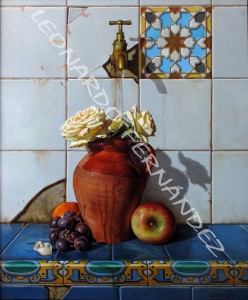Leonardo, by Francisco José Rodríguez Marín
 The name, which reminds us of the famous Renaissance artist, seems that you determined the trajectory of a Malaga, who from his earliest childhood underwent a deep and joyful vocation towards painting. A natural inclination that has been laboriously worked in a continuous search for the sake of the self-improvement and intense, and that has resulted in the precious and imitate nature that characterizes his work.
The name, which reminds us of the famous Renaissance artist, seems that you determined the trajectory of a Malaga, who from his earliest childhood underwent a deep and joyful vocation towards painting. A natural inclination that has been laboriously worked in a continuous search for the sake of the self-improvement and intense, and that has resulted in the precious and imitate nature that characterizes his work.
The painting of Leonardo is a world of personal seal, composed urban landscapes full of genuine beaty that has often had happened unnoticed, gotten compositions that pays tribute to great figures of universal painting or the painters of the 19th century from his native Malaga which both learned, traditionalists interiors filled with bucolismo and reminiscent of the warmth of home; or still lifes that dignify themselves through their inclusion in the work of art.
It is precisely still life the theme that has obtained a more personal vision in the work of Leonardo. Objects are recovered, sometimes, from the most forgotten daily to collect a new meaning. Choose materials of unexpected aesthetic qualities, whose contrasting textures are an excuse to make clear the deep technical mastery with which they are represented. But it is not just technical. A breath of life, suggest an intangible feeling that hands were that cut roses, which prepared those foods, which prepared the fruits under the coolness of the water. It is the contribution of the artist who lives his work and makes her part of himself.
Objects reminiscent of crafts and traditional customs or disappearing resulting in the viewer are often longing for times past or about to leave. Polychromatic tilework refers to techniques and knowledge that have survived unbowed from centuries ago, embroideries of a shawl to long evenings in which female hands drew flowers in a patient passing, to pure and simple foods that carry the label of the authentic, traditional, as always. What gives meaning to our existence, which makes it easier to identify. This is a rare virtue the patent to the passage of time without even referring it, and make it with renewed formulas of what contitutes a still life.
His particular eclecticism allows you to combine different painting techniques in a same pictura without any disagreement between them, or to return to pictorial resources utilized during the Baroque showing in full force in a new environment. Thus take place with the presence of pictures in the picture, with mirrors which provide illusory images that we take as real, who play with our feelings, taking advantage of the despite of our senses, engrossed with the virtuosity with which reality is represented. The herring and polished metal surface of a teapot or the translucent glass of a vial allow you to obtain elaborate effects of duplication of images which, however, are inserted in the work with extreme naturalness. There is always a second reality in the eyes of a magnifying glass, requiring the scrutinizing gaze that is not resigned to comply with the immediate appearance. A second more deep and thorough, reality that is present in the form of almost imperceptible dew drops, in subtle sparkles, unnotices strokes in an open book which allow its reading.
The other protagonist is the light. A clear, intense light, directed, almost always from side impact. Is it ths completes the picture. Which is responsable for modelling objects, give them volume and body, color, vividness and spatial sense within the composition. Objects, placed with apparent carelessness, are cleverly arranged to set up harmonious compositions which the sense of depth is not alien. Lights, shadows, gradients of color, or even own dematerialization of the bracket forwards us, not to a few inches beyond, but to another world, out of the cod-end at dawn, scenic countryside made with impressionist technique that contrast with the charged realism of delicate flowers, or scenes of the Alhambra that transports the picture withing the picture.
Thus occurs in collection of networks, where light graduation leads to a scene of twilight, framed as if it were a theatrical, jus implied scene through shadows that, however, it is fully contextualized thorug fishing-themed objects that make up a Symphony of tactile qualities. It is also contrast who brand the storyline of source with fruit, where the wall covered by multiple layers of lime and remodeled by the passage and neglect, shows his roughness through the grassed and the accumulation of pictorial matter which gives three-dimensional and they redeem him constitute a mere background. Water, eternal source of life, the fruit or the color of the geranium note comprise a vital dichotomy facing so much inert roughness.
The work of Leonardo Fernandez cannot be qualified more than mere painterly realism, but of a particular way of learning the reality mediated by their own experience and sensitivity. A reality that brings us back like a poem to constitute a world that we wouldn’t want to ever leave.
Francisco José Rodríguez Marín
Department of Art History
University of Málaga







This post has 0 Comments